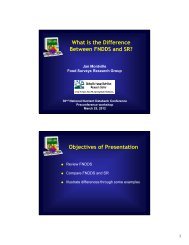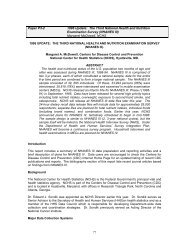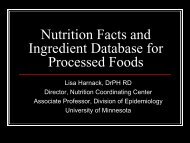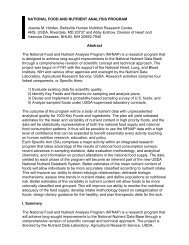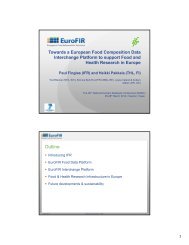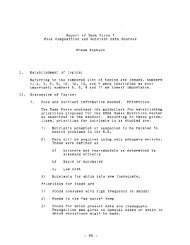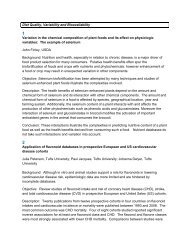Examining Phytosterols In Nuts and Seeds For The USDA National ...
Examining Phytosterols In Nuts and Seeds For The USDA National ...
Examining Phytosterols In Nuts and Seeds For The USDA National ...
Create successful ePaper yourself
Turn your PDF publications into a flip-book with our unique Google optimized e-Paper software.
<strong>Examining</strong> <strong>Phytosterols</strong> <strong>In</strong> <strong>Nuts</strong> <strong>and</strong><br />
<strong>Seeds</strong> <strong>For</strong> <strong>The</strong> <strong>USDA</strong> <strong>National</strong><br />
Nutrient Database for St<strong>and</strong>ard<br />
Reference<br />
Robin Thomas, Susan Gebhardt<br />
<strong>USDA</strong>-ARS Beltsville Human Nutrition Research<br />
Center, Nutrient Data Laboratory<br />
Katherine Phillips<br />
Virginia Polytechnic <strong>In</strong>stitute <strong>and</strong> State University
<strong>In</strong>troduction<br />
• <strong>Phytosterols</strong> have been in the <strong>USDA</strong><br />
<strong>National</strong> Nutrient Database for St<strong>and</strong>ard<br />
Reference (SR) since early 1980’s<br />
• Research has been evolving<br />
– reduction in serum cholesterol levels<br />
– improvements in analytical methods<br />
• <strong>Nuts</strong> <strong>and</strong> seeds are a significant dietary<br />
source of phytosterols
Occurrence of <strong>Phytosterols</strong><br />
• > 200 types<br />
– Most common = ß-sitosterol, campesterol,<br />
stigmasterol, Δ5-avenasterol<br />
– Stanols are subgroup of sterols<br />
• 4 different forms<br />
– Free sterols, steryl esters, steryl glycosides,<br />
<strong>and</strong> acylated steryl glycosides
ß-Sitosterol
ß-Sitostanol
Sterol Conjugates<br />
Steryl Esters<br />
Steryl Glycoside
Health Effects<br />
• Lower cholesterol<br />
– FDA health claim: > 1.3 g/day plant<br />
sterol esters or > 3.4 g/day of plant<br />
stanol esters may reduce risk of heart<br />
disease<br />
– ATP III: 2-3 g/day plant stanol/sterol<br />
esters reduce LDL cholesterol by 6-15<br />
percent<br />
• Reduced risk of certain cancers?
Addition of <strong>Phytosterols</strong> to Food<br />
Foods or beverages containing at least 0.4 g plant sterols,<br />
when consumed twice a day for a total intake of 0.8 g/day<br />
as part of a diet low in saturated fat <strong>and</strong> cholesterol, may<br />
reduce the risk of coronary heart disease. (FDA health claim)
Sources <strong>and</strong> <strong>In</strong>take<br />
• Primary natural sources:<br />
– vegetable oils (esp. corn oil), legumes, nuts,<br />
seeds, whole grains<br />
• Typical intake<br />
– 150-400 mg/day naturally occurring<br />
– vegetarians nearly 1 g/day
Analytical Methods<br />
• Separation of bound sterols<br />
– Acid hydrolysis to cleave free sterol from<br />
steryl glycoside<br />
– Alkaline hydrolysis (saponification) to cleave<br />
free sterol from steryl ester<br />
• Gas chromatography to separate <strong>and</strong><br />
quantify free <strong>and</strong> unbound sterols
Total <strong>Phytosterols</strong>¹ With <strong>and</strong><br />
Without Steryl Glycosides, mg/100g<br />
Food<br />
F + E²<br />
F + E + G³<br />
Difference<br />
Almonds<br />
137<br />
176<br />
22% (p
<strong>Phytosterols</strong> in SR19<br />
Currently report<br />
• ß-sitosterol<br />
• Campesterol<br />
• Stigmasterol<br />
• <strong>Phytosterols</strong> -- sum of<br />
these 3 sterols
Sources of <strong>Phytosterols</strong> in<br />
<strong>Nuts</strong> <strong>and</strong> <strong>Seeds</strong> in SR19<br />
1978 Weihrauch paper (literature review)<br />
– Nut data calculated based on sterols in nut oils<br />
– Source of seed data not revealed<br />
– Spice seed data from 1974 Japanese paper<br />
– SR includes total phytosterol data from paper<br />
for:<br />
• cashew, European chestnut, coconut, pine nut,<br />
sesame seed, sunflower seed, <strong>and</strong> 9 spice seeds<br />
– Suggests GC method used
Sources of <strong>Phytosterols</strong> in<br />
<strong>Nuts</strong> <strong>and</strong> <strong>Seeds</strong> in SR19<br />
1999 study<br />
– Collaboration between <strong>USDA</strong> <strong>and</strong> nut industry<br />
– Measured ß-sitosterol, campesterol, <strong>and</strong><br />
stigmasterol in:<br />
• almonds, hazelnuts, macadamia nuts, pecans,<br />
pistachio nuts, <strong>and</strong> English walnuts<br />
– Mostly n=1; walnuts <strong>and</strong> pecans n=3<br />
– Various commercial labs<br />
– Gas chromatography
Recent Literature Sources of<br />
Nut <strong>and</strong> Seed Sterols<br />
9 papers plus unpublished data, 2001-2007<br />
Grown in U.S. <strong>and</strong> other countries<br />
Some nuts fresh-harvested; others retail<br />
2 papers used HPLC, remaining used GC<br />
Majority quantified more than 3 sterols<br />
4 of 13 sources used acid hydrolysis
<strong>Phytosterols</strong> reported for almonds, mg/100g<br />
Source<br />
Number ß-Sito- Campe- Stigma- Brassica- ∆ 5 -avena- Sito- Campesamples<br />
sterol sterol sterol sterol sterol stanol stanol<br />
Other Total<br />
Almond Board 06a 19 114 5 3 30* 154<br />
Almond Board 06b 49 129 5 4 138<br />
Maguire 04 1 85 2 2 89<br />
Piironen 03 1 118 3 1 0 6 † 2 ‡ 130<br />
Phillips 05 4 143 5 5 20 3 3 20 199<br />
Normen 07 1 165 7 7 4 21 4 0 208<br />
SR19 1 111 5 4 120<br />
* total minor sterols (brassicasterol, campestanol, ∆7-campesterol, clerosterol, beta-sitostanol, ∆5-<br />
avenasterol, ∆7-avenasterol, ∆7-stigmasterol, <strong>and</strong> ∆7,25-stigmadienol)<br />
† reported as ∆5- + ∆7-avenasterols<br />
‡ reported as “stanols”<br />
Red indicates use of acid hydrolysis
<strong>Phytosterols</strong> reported for hazelnuts, mg/100g<br />
Source<br />
Number ß-Sito- Campe- Stigma- ∆ 5 -avena- ∆ 7 -avena- Sito- Campesamples<br />
sterol sterol sterol sterol sterol stanol stanol<br />
Other Total<br />
Alasalvar 06 6 82 6 1 9* 1 2 † 101<br />
Amaral 06 ‡ 19 94 7 1 7* 1 2 † 112<br />
Maguire 04 1 49 3 2 54<br />
Phillips 05 4 102 7 0 3 4 3 3 121<br />
Normen 07 1 122 8 2 7 0 139<br />
SR19 1 89 6 1 96<br />
* reported as ∆5-avenasterols <strong>and</strong> sitostanol<br />
† clerosterol <strong>and</strong> ∆7-stigmastenol reported separately in paper, but combined here<br />
‡ nuts were roasted<br />
Red indicates use of acid hydrolysis
<strong>Phytosterols</strong> reported for English walnuts, mg/100g<br />
Source<br />
Number ß-Sito- Campe- Stigma-Brassica-∆ 5 -avena- ∆ 7 -avena- Sito- Campe-<br />
Other Total<br />
Samples sterol sterol sterol sterol sterol sterol stanol stanol<br />
Amaral 03 6 143 8 0 52 2 2 206<br />
Maguire 04 1 57 3 3 63<br />
Phillips 05 4 89 5 0 7 0 2 9 113<br />
Normen 07 1 121 6 0 0 1 0 0 128<br />
SR19 3 64 7 1 72<br />
Red indicates use of acid hydrolysis
<strong>Phytosterols</strong> reported for pumpkin seed<br />
kernels*, mg/100g<br />
Number ß-Sito- Campe- Stigma- Brassica- ∆ 5 -avena- Sito- Campesamples<br />
sterol sterol sterol sterol sterol stanol stanol<br />
Source<br />
Other Total<br />
Phillips 05 1 13 3 0 4 4 1 241 265<br />
Normen 07 1 48 0 4 0 3 39 94<br />
*Phillips specifies kernels but Normen does not specify if seeds are hulled<br />
Red indicates use of acid hydrolysis
<strong>Phytosterols</strong> reported for sesame seeds, mg/100g<br />
Source<br />
Number ß-Sito- Campe- Stigma- Brassica- ∆ 5 -avena- Sito- Campesterol<br />
sterol sterol sterol sterol stanol stanol<br />
Samples<br />
Other Total<br />
Phillips 05* 1 232 53 22 40 0 6 47 400<br />
Normen 07 † 1 263 70 28 0 43 0 0 404<br />
SR19 ‡ 1 714<br />
* Decorticated<br />
† Not specified if decorticated or whole<br />
‡Whole<br />
Red indicates use of acid hydrolysis
Summary of Results in Comparison to SR19<br />
Total <strong>Phytosterols</strong>, mg/100g<br />
Type of Nut/Seed<br />
From Literature <strong>In</strong> SR19<br />
Almonds 89 - 208 120<br />
Brazil nuts 97 - 131 *<br />
Cashew 80 - 158 158<br />
Flaxseed 197 - 214 *<br />
Hazelnuts 54 - 121 96<br />
Macadamia 96 - 187 115<br />
Pecan 114 - 157 97<br />
Pine nut 161 - 236 141<br />
Pistachio 279 - 297 213<br />
Pumpkin seed 94 - 265 *<br />
Sesame seed 400 - 404 714<br />
Sunflower seed 176 - 322 534<br />
Walnuts, black † 177 108<br />
Walnuts, English 63 - 206 72<br />
* No data<br />
† Same composite was assayed for paper <strong>and</strong> SR19
Variation in Ways Phytosterol Data<br />
Reported in Literature<br />
• Number <strong>and</strong> types of different sterols quantified<br />
• Sterol peaks not identified<br />
• Minor sterols may be quantified individually or<br />
grouped together<br />
• Some sterol values include glycosidic portion <strong>and</strong><br />
others do not<br />
• Some values are reported as mg/100g oil<br />
• Lack of method validation/quality control in some<br />
studies
Additional Factors Affecting<br />
Differences Among Phytosterol<br />
Results in <strong>Nuts</strong> <strong>and</strong> <strong>Seeds</strong><br />
• Natural variability in sterol content between<br />
cultivars<br />
• Lack of detailed sample description<br />
• Sampling protocol<br />
• Data reported for nuts grown in countries<br />
other than U.S.<br />
• Number of samples
Conclusion<br />
• Different analytical methods currently used<br />
to measure phytosterols<br />
• Use of acid hydrolysis can have significant<br />
impact on results for nuts <strong>and</strong> seeds<br />
• Limited data available<br />
• Additional data on nuts <strong>and</strong> seeds needed<br />
• Research on other food sources needed




